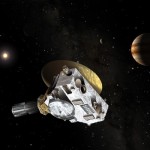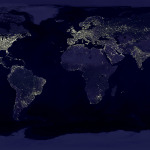Scientist Pinpoint Saturn’s Center With Exquisite Accuracy
Scientists have paired NASA’s Cassini spacecraft with the National Science Foundation’s Very Long Baseline Array (VLBA) radio-telescope system to pinpoint the position of Saturn and its family of moons to within about 2 miles (4 kilometers).
The measurement is some 50 times more precise than those provided by ground-based optical telescopes. The feat improves astronomers’ knowledge of Saturn’s orbit and benefits spacecraft navigation and basic physics research.
The team of researchers used the VLBA — a giant array of radio-telescope antennas spread from Hawaii to the Virgin Islands — to pinpoint the position of Cassini as it orbited Saturn over the past decade by receiving the signal from the spacecraft’s radio transmitter. They combined this data with information about Cassini’s orbit from NASA’s Deep Space Network. The combined observations allowed the scientists to make the most accurate determinations yet of the position of the center of mass, or barycenter, of Saturn and its numerous moons.
The study team included researchers from NASA’s Jet Propulsion Laboratory in Pasadena, California, and the National Radio Astronomy Observatory (NRAO) in Socorro, New Mexico. The scientists are presenting the results of their work today at the American Astronomical Society’s meeting in Seattle.
The new measurement was made possible by two factors: Cassini’s long-term presence in the Saturn system and the VLBA’s ability to discern extremely fine detail. The result is a greatly improved table of predicted positions of objects in the Saturn system, known as an ephemeris. An ephemeris is one of the basic tools of astronomy.
“This work is a great step toward tying together our understanding of the orbits of the outer planets of our solar system and those of the inner planets,” said Dayton Jones of JPL, who led the study.
The improved positional information will help enhance precise navigation of interplanetary spacecraft and help refine measurements of the masses of solar system objects. It will also improve predictions of when Saturn or its rings will pass in front of background stars — events that provide a variety of research opportunities for astronomers.



